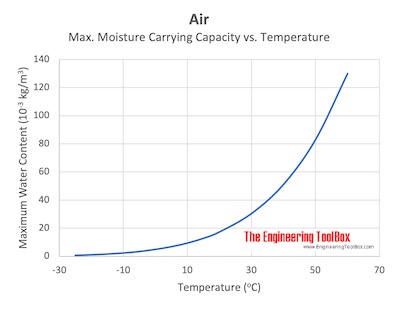Air - Maximum Moisture Carrying Capacity
Maximum water content in humid air vs. temperature.
The maximum moisture content possible in air - at saturation - varies with temperature. The table below indicates maximum moisture content in a cubic metre of air at various temperatures:
| Temperature | Max. Water Content | ||
|---|---|---|---|
| (oC) | (oF) | (10-3 kg/m3) | (10-3lb/ft3) |
| -25 | -13 | 0.64 | 0.040 |
| -20 | -4 | 1.05 | 0.066 |
| -15 | 5 | 1.58 | 0.099 |
| -10 | 14 | 2.31 | 0.14 |
| -5 | 23 | 3.37 | 0.21 |
| 0 | 32 | 4.89 | 0.31 |
| 5 | 41 | 6.82 | 0.43 |
| 10 | 50 | 9.39 | 0.59 |
| 15 | 59 | 12.8 | 0.8 |
| 20 | 68 | 17.3 | 1.07 |
| 30 | 86 | 30.4 | 1.9 |
| 40 | 104 | 51.1 | 3.2 |
| 50 | 122 | 83.0 | 5.2 |
| 60 | 140 | 130 | 8.1 |
- 10-3 kg/m3 = g/m3
Example - Moisture Carrying Capacity in Heated Air
Air is heated from 20 oC to 50 oC.
- from the table above the maximum moisture content in air at 20 oC is 17.3 g/m3, and
- the maximum moisture content in air with temperature 50 oC is 83 g/m3
The increased ability to carry moisture can be calculated as
100 % ((83 g/m3) - (17.3 g/m3)) / (17.3 g/m3)
= 380 %
This dramatic change is important to explain why heated air is so much more effective than cold air in drying processes.




